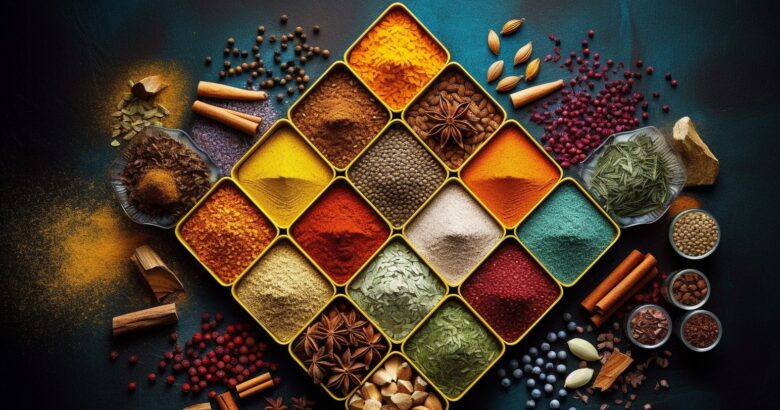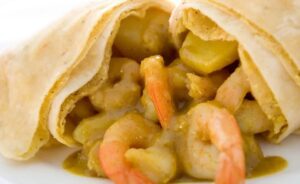Contents
Welcome to the captivating world of Trinidadian cuisine, where a rich tapestry of flavors and traditions unfolds on this culturally diverse Caribbean island. Trinidad, often celebrated for its vibrant Carnival and music scene, holds a culinary heritage just as remarkable, if not more so. In this article, we’ll delve into the heart of Trinidad’s gastronomy and the integral role spices play in shaping its distinctive flavors.
Trinidad’s culinary landscape is a testament to its multicultural history. Over centuries, Indigenous peoples, Africans, Indians, and Europeans have all left their indelible mark on the island’s food culture. This blend of influences has given rise to a unique and exciting fusion of flavors, making Trinidadian cuisine a true feast for the senses.
Yet, amidst the various culinary elements that contribute to Trinidad’s flavorful offerings, spices stand out as the unsung heroes. These aromatic ingredients hold the key to the island’s distinct taste profile. From fiery hot peppers to fragrant spices like pimento, cloves, and turmeric, each spice brings its own story and nuance to the Trinidadian table.
Join us on a journey as we unlock the secrets behind Trinidad’s mesmerizing spice blends. Discover the intricate art of seasoning, learn about signature dishes that showcase these flavors, and even uncover a few well-guarded spice blend recipes from the kitchens of Trinidadian households. By the end of this article, you’ll not only have a deeper appreciation for the island’s culinary heritage but also the tools to bring a taste of Trinidad into your own kitchen. Get ready to explore the world of “Island Flavors: Decoding Trinidad’s Spice Secrets.
1: The Spice Melting Pot
Trinidad’s allure lies not only in its stunning landscapes but also in its captivating history as a cultural melting pot. This island, nestled in the Caribbean Sea, has been shaped by the convergence of diverse cultures, each contributing its own unique spice to the rich tapestry of Trinidadian cuisine.
A Tapestry of Influences: Trinidad’s history as a cultural melting pot dates back centuries. Indigenous peoples, such as the Arawaks and Caribs, were the island’s original inhabitants, cultivating their own culinary traditions and flavors from the land’s bountiful resources.
The arrival of Africans through the transatlantic slave trade introduced a wealth of culinary knowledge and flavors. They brought with them techniques for using spices to enhance and preserve food, adding depth and complexity to Trinidad’s evolving cuisine.
In the 19th century, the British took control of Trinidad, followed by an influx of indentured laborers from India. These Indian immigrants brought their own intricate spice blends and cooking methods, leaving an indelible mark on the island’s culinary landscape.
European influences also played a role, with the Spanish and French contributing to the fusion of flavors through their cooking styles and ingredients.
Shaping Culinary Traditions: This diverse heritage has left an indelible mark on Trinidad’s culinary traditions, where the fusion of flavors from Indigenous, African, Indian, and European sources has created a unique and exciting gastronomic experience.
The use of spices in Trinidadian cuisine is a testament to this multicultural heritage. Each group’s distinct spice preferences and preparation techniques have intertwined over the years, resulting in the complex and layered flavors that define Trinidad’s dishes.
The spices used in Trinidadian cuisine serve not only to add taste but also to symbolize the island’s rich history and cultural diversity. They are a reflection of the island’s people and their resilience, creativity, and adaptability in the face of adversity.
Intriguingly, the combination of these diverse culinary influences has made Trinidadian cuisine a harmonious blend of flavors. The use of spices in Trinidad isn’t merely about heat; it’s about balance, harmony, and the celebration of Trinidad’s multiethnic heritage.
As we continue our exploration of Trinidad’s spice secrets, keep in mind how this remarkable history has led to the vibrant, flavorful, and culturally significant cuisine we’re about to uncover.
2: Key Trinidadian Spices
To truly appreciate the magic of Trinidadian cuisine, it’s essential to get acquainted with the array of spices that infuse its dishes with distinct flavors and aromas. Let’s delve into some of the essential spices that are the heart and soul of Trinidadian cooking, each contributing its unique character to the culinary tapestry.
1. Pimento (Allspice): Pimento, often referred to as allspice, is a cornerstone of Trinidadian spice blends. This aromatic berry boasts a warm, earthy flavor with hints of clove, cinnamon, and nutmeg. Its name, “allspice,” is a nod to the spice’s ability to evoke the combined essence of several spices in one.
2. Turmeric: Turmeric, with its vibrant yellow hue, adds both color and flavor to Trinidadian dishes. Known for its earthy, slightly bitter taste, turmeric imparts a warm and peppery note, balancing the overall flavor profile. It’s also highly regarded for its potential health benefits.
3. Cloves: Cloves bring a touch of sweetness and a subtle hint of heat to Trinidadian cuisine. These dried flower buds have a warm, pungent aroma and a strong, slightly sweet taste, making them a staple in spice blends and savory dishes.
4. Cumin: Cumin seeds offer a warm, nutty, and earthy flavor that’s indispensable in Trinidad’s spice repertoire. They add depth and complexity to dishes like curry and jerk seasoning, enhancing the overall aroma and taste.
5. Coriander: Coriander, in both seed and leaf form (known as cilantro), is cherished for its citrusy, slightly floral flavor. The seeds, when toasted and ground, contribute a warm and fragrant quality to Trinidadian spice mixes.
6. Fenugreek: Fenugreek seeds bring a unique and slightly bitter taste, often described as earthy with a hint of maple. These seeds are particularly vital in Trinidadian curry powders, imparting a distinctive aroma and flavor.
7. Hot Peppers: No discussion of Trinidadian spices would be complete without hot peppers, such as Scotch bonnet or Trinidad Moruga Scorpion peppers. These fiery gems not only provide intense heat but also contribute fruity and floral undertones to dishes like pepper sauce and jerk seasoning.
8. Cinnamon: Cinnamon, typically used in its stick form, adds a sweet and warm aroma to Trinidadian cuisine. It’s often utilized in spice blends and desserts to infuse a hint of sweetness.
9. Nutmeg: Nutmeg, with its sweet and nutty flavor, graces Trinidadian dishes with a warm, comforting essence. Grated nutmeg is commonly used as a finishing touch on soups, stews, and drinks.
Each of these spices plays a vital role in Trinidadian cuisine, contributing a unique flavor profile that defines the island’s culinary identity. As we uncover Trinidad’s spice secrets, remember that it’s the skillful combination and balance of these spices that elevate Trinidadian dishes to the level of culinary artistry.
3: Spice Blending Techniques
Trinidadian cuisine is as much about the art of spice blending as it is about the spices themselves. Trinidadian cooks have perfected the craft of creating intricate spice blends that elevate their dishes to new heights. Let’s take a closer look at the traditional methods and techniques that make Trinidad’s spice blending truly exceptional.
1. Toasting and Grinding: One of the fundamental techniques in Trinidadian spice blending is toasting and grinding spices. Whole spices like cumin, coriander, and fenugreek are dry-roasted in a pan to unlock their full flavor potential. After toasting, the spices are ground to a fine powder using a mortar and pestle or a spice grinder. This process intensifies the aromas and ensures even distribution of flavors in the dish.
2. Creating Curry Powders: Curry is a cornerstone of Trinidadian cuisine, and creating the perfect curry powder is an art form. Trinidadian curry powders are meticulously crafted by blending various spices in precise proportions. Common ingredients include turmeric, cumin, coriander, fenugreek, and mustard seeds. The blend is adjusted to achieve the desired level of heat and complexity.
3. Crafting Jerk Seasoning: Jerk seasoning, known for its fiery and flavorful punch, is another masterpiece in Trinidad’s spice arsenal. Trinidadian cooks create jerk seasoning by combining ingredients like Scotch bonnet peppers, allspice, thyme, garlic, and ginger. The key is achieving a balance between the heat of the peppers and the aromatic spices, resulting in a marinade that infuses meats with a tantalizing kick.
4. Balancing Flavors: The art of spice blending in Trinidadian cuisine is all about balance. Cooks take great care to harmonize the flavors of sweet, savory, bitter, and spicy elements in their spice mixes. Achieving the perfect equilibrium ensures that no single flavor dominates, allowing the complexity of the spices to shine through.
5. Heat Control: While Trinidadian cuisine is known for its heat, experienced cooks understand that it’s not just about making dishes fiery hot. Controlling the level of heat is crucial to allow the subtler flavors of the spices to emerge. Achieving this balance is a skill that requires both knowledge and finesse.
6. Personalized Spice Mixes: Many Trinidadian cooks have their secret spice blend recipes passed down through generations. These personalized blends often contain unique ingredients and ratios, reflecting the family’s culinary traditions and preferences. These closely guarded secrets contribute to the diversity and depth of Trinidadian flavors.
In Trinidad, the creation of spice blends is not just a culinary task but an expression of artistry and tradition. The dedication to balancing flavors and mastering heat is what sets Trinidadian cooks apart, turning every meal into a sensory adventure. As we journey deeper into Trinidad’s spice secrets, remember that it’s these techniques that make the cuisine so exceptional.
4: Signature Trinidadian Dishes
Trinidadian cuisine boasts a plethora of iconic dishes that showcase the remarkable use of spices. These dishes not only tantalize the taste buds but also offer a window into the heart of Trinidad’s culinary traditions. Let’s explore a few signature Trinidadian dishes and unravel how the spices elevate their flavor profiles.
1. Roti: Roti is a beloved Trinidadian flatbread, but it’s not just any bread; it’s a canvas for a vibrant spice-infused filling. The filling can include curried meats (such as chicken, goat, or shrimp) or vegetarian options like chana (chickpeas). Trinidadian roti relies on a blend of spices like cumin, coriander, turmeric, and cayenne pepper. These spices create a flavorful and aromatic curry that envelops the protein or legumes, turning the simple bread into a fragrant and satisfying meal.
2. Curry: Curry dishes hold a special place in Trinidadian hearts. The secret to Trinidadian curry’s distinctive taste lies in its spice blend, which typically includes turmeric, cumin, coriander, fenugreek, and mustard seeds. The spices add depth and complexity to the dish, with turmeric providing the golden color. Whether it’s curry chicken, beef, or vegetables, the spices transform the ingredients into a rich, flavorful stew that’s perfectly balanced in taste and aroma.
3. Jerk Chicken: Jerk chicken is a Caribbean classic, and in Trinidad, it’s a culinary gem. The jerk seasoning, a blend of allspice, Scotch bonnet peppers, thyme, garlic, and other spices, is the star of the show. These spices infuse the chicken with an irresistible combination of smokiness, heat, and a hint of sweetness. The result is a tender and flavorful dish that’s both spicy and aromatic.
4. Doubles: Doubles are a popular street food in Trinidad, featuring fried dough (bara) filled with curried chickpeas and various chutneys and sauces. The key to the delectable flavor of doubles is the spice-infused chickpea curry. Spices like cumin, turmeric, and garam masala create a savory and aromatic curry that perfectly complements the soft, fried bara. The spices not only provide a burst of flavor but also lend complexity to the overall dish.
5. Pelau: Pelau is a one-pot wonder that marries the flavors of meat, rice, pigeon peas, and spices. The spices used, including pimento, thyme, and hot peppers, give pelau its signature smoky and spicy taste. The spices are sautéed with the meat and rice, creating a deep and aromatic foundation that infuses every bite with a delightful blend of flavors.
In these signature Trinidadian dishes, the spices serve as the primary catalysts for flavor enhancement. They not only provide depth and complexity but also highlight the multicultural heritage of the cuisine. Trinidadian cooks masterfully utilize these spices to create a harmonious symphony of taste and aroma that leaves a lasting impression on anyone fortunate enough to savor these iconic dishes.
5: Unveiling Secret Recipes
Unlocking the secrets of Trinidad’s spice blends wouldn’t be complete without sharing a glimpse into some treasured recipes from Trinidadian households and local chefs. These blends, often closely guarded family traditions, add a touch of magic to the island’s cuisine. Today, we invite you to explore a few of these secret or lesser-known spice blend recipes and encourage you to embark on your own culinary journey.
1. Trinidadian Green Seasoning: Green seasoning is the lifeblood of Trinidadian cooking, used as a marinade, sauce, or flavor enhancer in numerous dishes. To create your own, blend fresh herbs like cilantro, parsley, and chives with garlic, ginger, hot peppers (adjust to your heat tolerance), and vinegar. Add a touch of thyme and shadow beni (culantro) for an authentic twist. This vibrant green concoction will infuse your dishes with the essence of Trinidad.
2. Trinidadian Curry Powder: Crafting your Trinidadian curry powder allows you to control the flavors to your liking. Combine ground spices like turmeric, cumin, coriander, fenugreek, and mustard seeds. Adjust the ratios to achieve your preferred level of heat and complexity. Homemade curry powder brings an authentic Trinidadian touch to your curries and stews.
3. Trinidadian Jerk Seasoning: Jerk seasoning is synonymous with Caribbean cuisine. Create your own by blending allspice, Scotch bonnet peppers, thyme, garlic, ginger, and a hint of cinnamon and nutmeg. Adjust the number of peppers to control the heat. Marinate your choice of protein (chicken, pork, or even tofu) for hours or overnight, and then grill or roast for a mouthwatering, spicy delight.
4. Pepper Sauce: Trinidadian pepper sauce is a fiery condiment that adds a kick to any meal. Combine hot peppers, garlic, vinegar, and a pinch of salt in a blender. Adjust the pepper-to-vinegar ratio to your heat preference. Bottle it up, let it ferment for a few days, and you’ll have a homemade hot sauce ready to spice up your dishes.
5. Achar (Pickled Vegetables): Achar is a tangy, spiced pickled vegetable dish that adds a burst of flavor to Trinidadian meals. Create your own by combining grated green mangoes, carrots, cucumbers, and hot peppers. Season with mustard seeds, cumin, fenugreek, turmeric, and a dash of vinegar. This delightful condiment pairs well with rice and curry or doubles.
These secret recipes and spice blends offer a taste of Trinidadian culinary heritage, allowing you to recreate the flavors of the island in your own kitchen. Experiment with these recipes, adjust the spice levels to your liking, and savor the joy of cooking Trinidadian dishes with your homemade spice blends. As you explore the world of Trinidad’s spice secrets, remember that the true magic lies in the hands of the cook, so embrace the journey and savor every delicious step.
6: Spice Markets and Tours
If you’re planning a visit to Trinidad and wish to immerse yourself in the world of spices, exploring local spice markets and taking spice tours is a must. These experiences will not only tantalize your senses but also offer a deeper understanding of Trinidad’s vibrant culinary heritage. Here’s what you can expect and where to find these enriching experiences:
1. Local Spice Markets: a. Chaguanas Market: Located in the town of Chaguanas, the Chaguanas Market is a bustling hub of activity where you’ll find an array of spices, fresh produce, and local delicacies. It’s the perfect place to sample and purchase Trinidad’s signature spices, including pimento, turmeric, and hot peppers. Engage with local vendors who can share their spice knowledge and even offer tips on using them in your cooking.
b. San Fernando Market: San Fernando Market, in the southern part of Trinidad, is another vibrant market where you can explore the diversity of Trinidadian spices. Stroll through the stalls and discover the colors and aromas of the island’s culinary treasures. Don’t forget to haggle for spices, dried herbs, and spice blends to take home as souvenirs.
2. Spice Tours: a. Trini Spice Tours: Trini Spice Tours offers an immersive journey into Trinidad’s spice culture. Led by knowledgeable guides, you’ll explore spice farms and plantations, where you can witness the cultivation and harvesting of spices. You’ll also have the chance to participate in spice blending workshops, gaining hands-on experience in creating authentic Trinidadian spice blends.
b. Chaguaramas Estate Spice Tour: The Chaguaramas Estate Spice Tour provides an opportunity to visit a working spice estate, located in the lush northern region of Trinidad. You’ll gain insights into the cultivation of spices such as nutmeg, cocoa, and cinnamon. The tour typically includes spice tastings and demonstrations, offering a well-rounded educational experience.
What to Expect:
- Aromas and Flavors: In local spice markets, prepare to be greeted by a symphony of aromas as you navigate stalls brimming with spices, herbs, and dried fruits. You’ll have the chance to taste, smell, and even sample some of the spices, enhancing your sensory experience.
- Engaging with Locals: Spice markets are excellent places to engage with friendly locals who are passionate about their culinary heritage. Don’t hesitate to strike up conversations with vendors and ask for recommendations on spice usage and traditional dishes.
- Educational Insights: Spice tours offer a deeper understanding of spice cultivation, processing, and blending techniques. You’ll learn about the history, cultural significance, and health benefits of various spices, enhancing your appreciation of Trinidadian cuisine.
- Hands-On Experience: Some spice tours may provide hands-on experiences, allowing you to participate in spice blending workshops or cooking demonstrations. These activities offer a chance to apply what you’ve learned and create your own spice blends.
- Culinary Souvenirs: Spice markets are fantastic places to purchase unique culinary souvenirs. Bring home Trinidadian spices, spice blends, sauces, and condiments to infuse your cooking with the flavors of the island.
Visiting local spice markets and taking spice tours in Trinidad promises a delightful adventure for food enthusiasts and travelers alike. These experiences not only connect you with the vibrant culinary culture of the island but also leave you with lasting memories and a newfound appreciation for the magic of Trinidad’s spices.
Conclusion:
In the colorful tapestry of Trinidadian cuisine, spices stand as the threads that weave together the island’s rich culinary heritage. These aromatic ingredients, shaped by centuries of diverse influences, play a pivotal role in defining the distinctive flavors of Trinidad. From the pungent allure of allspice to the golden hues of turmeric, and the fiery dance of Scotch bonnet peppers, spices are the soul of Trinidadian dishes.
Their significance extends far beyond mere flavor; spices encapsulate the island’s history, culture, and resilience. Trinidadian cooks have mastered the art of blending and balancing these spices, creating dishes that are a harmonious fusion of tradition and innovation.
As you’ve embarked on this journey to decode Trinidad’s spice secrets, we invite you to explore Trinidad’s culinary world further. Try your hand at creating Trinidadian spice blends, cook up iconic dishes like roti, curry, and jerk chicken, and savor the unique flavors of the island in your own kitchen. Venture into local spice markets and embark on spice tours to deepen your connection with Trinidad’s culinary traditions.
Trinidad’s spice secrets are not just about the ingredients; they are a celebration of the island’s vibrant culture, its people, and their love for food. So, go forth and let the aromas and flavors of Trinidad transport you to a world of culinary enchantment. Embrace the experience, and may your own exploration of “Island Flavors: Decoding Trinidad’s Spice Secrets” be as flavorful as the journey itself.
Download our ebook and explore Trinidad

The e-book ‘Trinidad Unearthed:
The Explorer’s Comprehensive Guide to the Island’s Secrets’, written by Aiden Ramnarine, A detailed guide to exploring the secrets and beauties of Trinidad. Spanning from the island’s geography and climate to its hidden cultural and culinary jewels, the book offers a deep insight into local experiences, outdoor activities, and sustainable tourism practices. Ideal for adventurous travelers, this guide is a valuable tool for discovering Trinidad in an authentic and responsible way.




